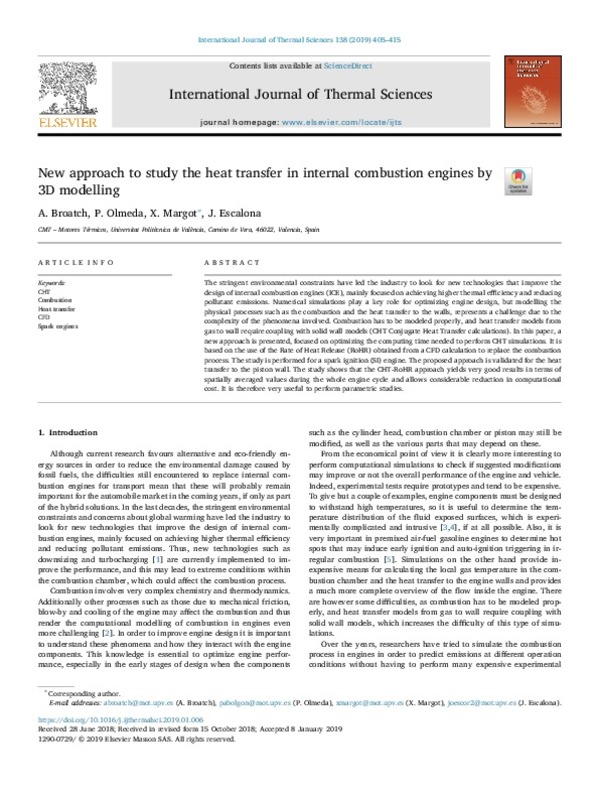JavaScript is disabled for your browser. Some features of this site may not work without it.
Buscar en RiuNet
Listar
Mi cuenta
Estadísticas
Ayuda RiuNet
Admin. UPV
New approach to study the heat transfer in internal combustion engines by 3D modelling
Mostrar el registro sencillo del ítem
Ficheros en el ítem
| dc.contributor.author | Broatch, A.
|
es_ES |
| dc.contributor.author | Olmeda, P.
|
es_ES |
| dc.contributor.author | Margot, Xandra
|
es_ES |
| dc.contributor.author | Escalona-Cornejo, Johan Enrique
|
es_ES |
| dc.date.accessioned | 2019-10-24T06:43:31Z | |
| dc.date.available | 2019-10-24T06:43:31Z | |
| dc.date.issued | 2019 | es_ES |
| dc.identifier.issn | 1290-0729 | es_ES |
| dc.identifier.uri | http://hdl.handle.net/10251/129374 | |
| dc.description.abstract | [EN] The stringent environmental constraints have led the industry to look for new technologies that improve the design of internal combustion engines (ICE), mainly focused on achieving higher thermal efficiency and reducing pollutant emissions. Numerical simulations play a key role for optimizing engine design, but modelling the physical processes such as the combustion and the heat transfer to the walls, represents a challenge due to the complexity of the phenomena involved. Combustion has to be modeled properly, and heat transfer models from gas to wall require coupling with solid wall models (CHT Conjugate Heat Transfer calculations). In this paper, a new approach is presented, focused on optimizing the computing time needed to perform CHT simulations. It is based on the use of the Rate of Heat Release (RoHR) obtained from a CFD calculation to replace the combustion process. The study is performed for a spark ignition (SI) engine. The proposed approach is validated for the heat transfer to the piston wall. The study shows that the CHT-RoHR approach yields very good results in terms of spatially averaged values during the whole engine cycle and allows considerable reduction in computational cost. It is therefore very useful to perform parametric studies. | es_ES |
| dc.description.sponsorship | This project has received funding from the European Union's Horizon 2020 research and innovation programme under grant agreement No 724084. | es_ES |
| dc.language | Inglés | es_ES |
| dc.publisher | Elsevier | es_ES |
| dc.relation.ispartof | International Journal of Thermal Sciences | es_ES |
| dc.rights | Reconocimiento - No comercial - Sin obra derivada (by-nc-nd) | es_ES |
| dc.subject | CHT | es_ES |
| dc.subject | Combustion | es_ES |
| dc.subject | Heat transfer | es_ES |
| dc.subject | CFD | es_ES |
| dc.subject | Spark engines | es_ES |
| dc.subject.classification | INGENIERIA AEROESPACIAL | es_ES |
| dc.subject.classification | MAQUINAS Y MOTORES TERMICOS | es_ES |
| dc.title | New approach to study the heat transfer in internal combustion engines by 3D modelling | es_ES |
| dc.type | Artículo | es_ES |
| dc.identifier.doi | 10.1016/j.ijthermalsci.2019.01.006 | es_ES |
| dc.relation.projectID | info:eu-repo/grantAgreement/EC/H2020/724084/EU/Efficient Additivated Gasoline Lean Engine/ | es_ES |
| dc.rights.accessRights | Abierto | es_ES |
| dc.contributor.affiliation | Universitat Politècnica de València. Departamento de Máquinas y Motores Térmicos - Departament de Màquines i Motors Tèrmics | es_ES |
| dc.description.bibliographicCitation | Broatch, A.; Olmeda, P.; Margot, X.; Escalona-Cornejo, JE. (2019). New approach to study the heat transfer in internal combustion engines by 3D modelling. International Journal of Thermal Sciences. 138:405-415. https://doi.org/10.1016/j.ijthermalsci.2019.01.006 | es_ES |
| dc.description.accrualMethod | S | es_ES |
| dc.relation.publisherversion | https://doi.org/10.1016/j.ijthermalsci.2019.01.006 | es_ES |
| dc.description.upvformatpinicio | 405 | es_ES |
| dc.description.upvformatpfin | 415 | es_ES |
| dc.type.version | info:eu-repo/semantics/publishedVersion | es_ES |
| dc.description.volume | 138 | es_ES |
| dc.relation.pasarela | S\383358 | es_ES |
| dc.contributor.funder | European Commission | es_ES |








